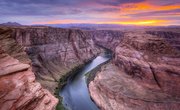
Often proceeding at small, subtle and slow rates, weathering fragments or dissolves rock: a hugely influential geological process that commonly sets the stage for erosion and provides the critical “parent material” for developing soils. The type of rock certainly influences the kind, degree and pace of weathering it will be vulnerable to, although many other factors come into play – not least the surrounding climate.
TL;DR (Too Long; Didn't Read)
Weathering breaks down rock through mechanical or chemical processes. Different types of rock have different resistance to weathering, but many other factors besides basic mineral content influence weathering rates, including climate.
Types of Weathering
Weathering takes apart rock by mechanical disintegration or chemical decomposition. Mechanical (or physical) weathering refers to rock fragmentation by such forces as ice- or salt-wedging and the unloading of pressure on rocks formed far underground and then exposed at the Earth’s surface. Chemical weathering, meanwhile, covers processes that weather rock through chemical reactions, as when minerals in rocks are dissolved or replaced through exposure to air or water.
Relative Rock Resistance to Weathering
The relative resistance or “toughness” of a given rock to weathering certainly depends partly on what kind of rock it is. That’s because rock type is determined by the composition and proportion of the constituent minerals, and different minerals vary in how they stand up to weathering. Quartz, for example, is more resistant that micas, which in turn are more resistant than feldspars. But you can’t really make a general ranking of rock types by resistance to weathering because of all the other variables involved.
Not all rocks within a given type, such as granite and limestone, have the same mineralogy, for one thing. Sandstones, for examples, are made of sand grains bound by a wide range of cementing materials, and their toughness hinges on that of their cement: A sandstone cemented by silica is more resistant than one cemented by calcium carbonate.
More massive rocks – those with fewer fractures, joints or bedding planes, which are the borders between individual layers in sedimentary rocks – tend to resist weathering more effectively than less massive ones, because those cuts provide points of entry (or attack) to weathering agents such as water, which in freeze-thaw cycles pries rock apart and which also serves as a medium for chemical weathering.
The Influence of Climate
And then there’s the climate factor. Very roughly speaking, mechanical weathering tends to be a more dominant force in drier climates, while humid climates see more pronounced chemical weathering. Many rocks are resistant to one kind of weathering and weak against the other. Limestone, for instance, is notably prone to chemical weathering given the solubility of its carbonate rock; in humid limestone provinces, caves and caverns – examples of karst landforms – abound. In arid country, by contrast, limestone can be quite resistant and often forms scarps. For example, limestone – along with sandstone and conglomerate – creates bold cliffbands in the Grand Canyon of the Colorado Plateau, while weaker shale weathers to gentle strata between those tougher layers.
Effects of Differential Weathering on Landscapes
In a region containing multiple kinds of rock, their relative weathering resistance or lack thereof helps shape the lay of the land. Roughly speaking, rock layers standing high on the countryside are more resistant to weathering, as well as erosion – the two forces go hand-in-hand – than those underlying valleys and other lowlands. In the Valley and Ridge Province of the Appalachian Mountains, more resistant sandstone and conglomerate serve as “ridge-makers,” while weaker limestones and shales form valleys.
Weathering on certain rock types produces distinctive landforms. Granite outcrops often manifest as domes, walls and boulder fields, terrain that in some cases partly stems from a form of mechanical weathering called exfoliation (though chemical weathering may also contribute) that's best observed in granitic rocks. These form deep below the Earth’s surface; when exposed by uplift or erosion, they may respond to the unloading of pressure by shedding plates or strips of stone to create these monolithic landforms.
Weathering and Soil
By breaking rock into smaller and smaller pieces and freeing minerals, weathering acts as one of the chief soil-making forces. Weathered rock provides what’s called the “parent material,” lending both structure and nutrients to developing soil. Here again, the type of rock matters because of the kinds of minerals and the size of particles that weathering extracts from it. For example, sandstone often weathers into large particles to produce a coarse-textured soil more easily permeated by air and water, as opposed to the finer-textured, less-penetrable soil derived from weathered shale’s smaller particles.
Calcium is closely linked with soil fertility, and calcium-rich rocks tend to both weather fairly quickly and supply soil with plentiful clays – the particles which facilitate a lot of the essential nutrient uptake by plant roots. Soil weathered from calcium-rich ferromagnesium rocks such as basalt, andesite and diorite thus tends to be more fertile than those developed over acidic igneous rocks such as granite and rhyolite.
References
- Forest Ecosytems; David A. Perry, et al.
- Physical Geography: A Landscape Appreciation; Tom L. McKnight
- Essentials of Physical Geography; Robert Gabler, et al.
- U.S. Geological Survey: Valley & Ridge Province
- The Origin of Landscapes: A Synthesis of Geomorphology; H.F. Garner
- Fundamentals of Physical Geography; David John Briggs, Peter Smithson
About the Author
Ethan Shaw is an independent naturalist and freelance outdoors/nature writer based in Oregon. He holds a B.S. in Wildlife Ecology and a graduate certificate in G.I.S. from the University of Wisconsin-Madison. His primary interests from both a fieldwork and writing perspective include landscape ecology, geomorphology, the classification of ecosystems, biogeography, wildlife/habitat relationships, and historical ecology. He’s written for a variety of outlets, including Earth Touch News, RootsRated, Backpacker, Terrain.org, and Atlas Obscura, and is presently working on a field guide.
